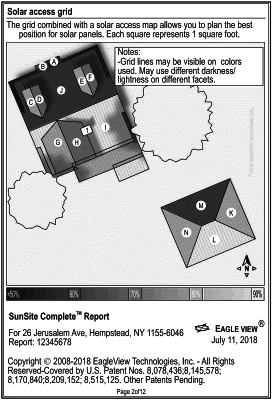| CPC G06T 17/05 (2013.01) [H02J 3/004 (2020.01); G06F 30/13 (2020.01); G06T 19/00 (2013.01); G06T 2210/56 (2013.01)] | 20 Claims |

|
1. A method for determining solar access, comprising:
retrieving a three-dimensional geo-referenced model of at least a part of a structure based at least in part on location information indicative of location of the structure, wherein geographic location on the earth of points in the three-dimensional geo-referenced model are stored or associated with points in the three-dimensional geo-referenced model;
retrieving object point cloud data indicative of one or more objects that cast shade on the structure based at least in part on the location information, wherein the object point cloud data is generated from one or more georeferenced images and the object point cloud data is indicative of an actual size, shape, and location of the one or more objects on the earth;
determining a solar access value for a vertex of the structure by:
calculating a ray between a sun position and the vertex at a plurality of time periods;
comparing a path of the ray to the location of points in the object point cloud data representative of the size, shape, and location of the one or more objects in relation to the path of the ray to determine that the one or more objects blocks the ray from reaching the vertex, resulting in a shadow over the vertex for at least one of the plurality of time periods;
determining maximum possible irradiance values at the vertex for the plurality of time periods, the maximum possible irradiance values based on solar radiation of the rays from above the vertex at the plurality of time periods and on solar irradiance from surrounding ground and atmospheric refractions to the vertex at the plurality of time periods;
determining a distance between the one or more objects blocking the ray from reaching the vertex and the vertex, based on the location of the one or more objects and a location of the vertex;
determining effects of the shadow over the vertex on the maximum possible irradiance values for the at least one of the plurality of time periods based on the determined distance and whether the vertex is within an umbra, penumbra, or antumbra of the shadow at the at least one of the plurality of time periods; and
determining irradiance in Watts per time period over the plurality of time periods in which the shadow is over the vertex.
|